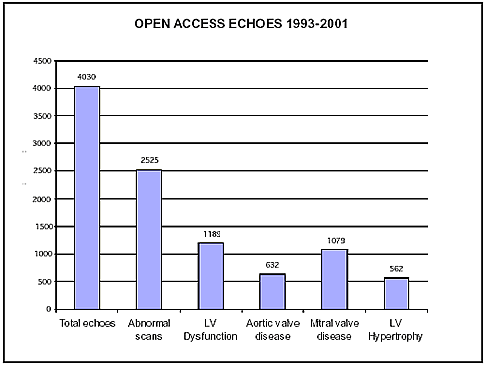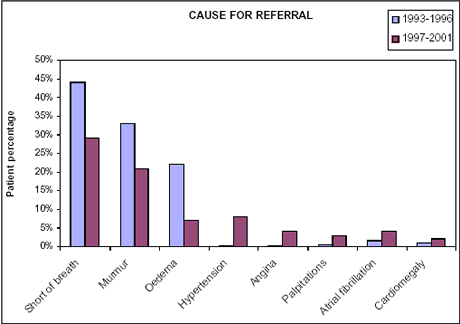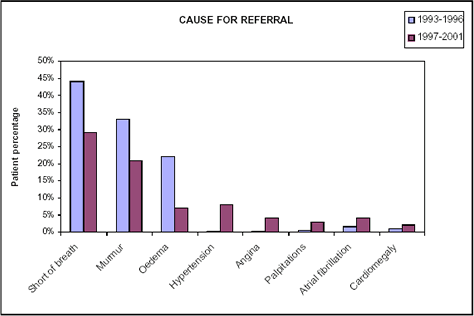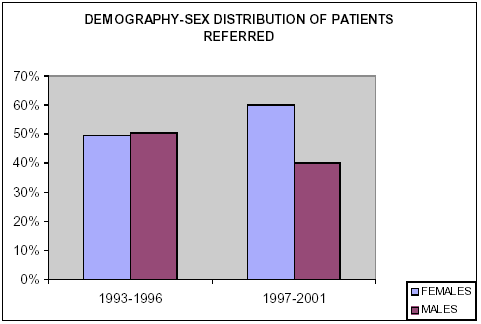Evolving trends in open access echocardiographyexperience over eight years
Archana RaoSpecialist Registrar Cardiology
Cardio thoracic Centre,
Liverpool
David Henton
Cardiac Physiologist
Department of Cardiovascular Medicine,
Queens Medical Centre, University Hospital Nottingham.
John Walsh
Consultant cardiologist
Department of Cardiovascular Medicine,
Queens Medical Centre, University Hospital Nottingham.
Abstract
Background
The use of open access echocardiography aids early diagnosis and treatment of cardiac conditions by general practitioners (GPs) potentially reducing the burden on secondary care. Increased awareness and advances in treatment are likely to impact on echocardiography demand.Aim
To undertake a retrospective review of referrals to an open access echocardiography service and study changes in referral patterns over an 8- year period.Methods
The characteristics and echocardiographic findings of 4030 patients referred for open access echocardiography between 1993-2001 were reviewed. To gain insight into evolving trends, data was divided into 2 time periods- referrals received between 1993 -1996 and those received between 1997-2001.Results
2525/4030 (63%) studies were abnormal; were due mostly due to 1189/4030 (30%) left ventricular systolic dysfunction (LVSD) and 1079/4030 (26.7%) mitral valve disease. Other reported abnormalities included aortic valve disease, left ventricular hypertrophy, tricuspid valve disease, pericardial effusion, patent foramen ovale, ventricular septal defect and atrial septal defects. The most common echo request was for "suspected heart failure". 2000 echoes were performed between 1993-1996 and 2030 were performed between1997-2001. However, the waiting time was much longer in the latter period. A significant reduction in the number of abnormal scans- 1497/2000(75%) to 1028/2030 (50%) was noted; (p<0.001). The overall prevalence of LVSD dropped from 872(43.6%) to 317(15.6%); (p<0.001).Conclusions
Open access echocardiography is increasingly popular with GPs and referral patterns have changed with time. A reduction in the number of positive scans was noted. Additional screening to improve diagnostic yield may be essential to balance capacity and demand.
Key words: Open access echocardiography; Left ventricular systolic dysfunction: Screening
INTRODUCTION
The use of open access echocardiography is rapidly rising, with a wide range of clinical reasons being cited for the requests. The positive yield for a scan varies with reasons for request and our data suggests that only half of the scans are positive. We report on a large cohort of open access echocardiography patients over a period of 8 years and reflect trends that are likely to have an impact on provision of care. As the numbers of requests escalate, the use of alternative screening techniques to improve diagnostic yield should be considered to keep the service viable and efficient. Open access echocardiography is defined as echocardiography requested by a general practitioner (GP) without prior clinical assessment by a cardiologist (Chambers et al 1999). There has been recent increase in the number of centres providing open access echocardiography services (Francis et al 1995) due to an increased demand from primary care (Saltissi S et al 1998). GPs in the community are increasingly managing patients with cardiac disease within primary care. The rationale for open access diagnostic services is that they allow early diagnosis and treatment, which in turn may reduce the burden on secondary care services (Chambers et al 1999;Kerrigan DD et al 1990). This strategy has been recommended in the National Service Framework (NSF) for coronary heart disease (Dept of Health, 2000).
Aims
To retrospectively assess the use of an open access echocardiography service by local general practitioners (GP) over an 8-year period and study changes in referral patterns over time.
Methods
A retrospective review of all referrals to an open access echocardiography service was undertaken. Information on patient demography, indication for echocardiography and results was collected.
Data collection
Data was collected retrospectively by assessment of individual request cards and corresponding echo reports. This data was then collated over 2 time periods i.e 1993-1996 and 1997-2001. In the period between 1996- 1997 the service was briefly suspended due to staffing problems.
Open access echo service
Queens Medical Centre (QMC), Nottingham is a 1400 bed University Hospital, serving approximately a population of around 600,000. Local GPs were informed of the service development and issued with request cards. The request card incorporated - patient details: including age, sex, symptoms and suspected diagnosis.
The service was restricted to adults. There were no formal exclusion criteria for use of the service although GPs were encouraged to refer patients with suspected heart failure, those with shortness of breath without a clear diagnosis and those with heart murmurs. Patient information was obtained from the details provided on the request card.Echocardiography
Echocardiograms were recorded in hospital, with a Siemens, ACUSON, Sequoia or Hewlett Packard ultra-machine equipped with a 3.5 MHz annular-array transducer. Subjects were studied supine in left lateral position with recordings made from standard apical and para-sternal long and short-axis views. M-mode recordings were made at the tips of the mitral valve leaflets from which end-diastolic and end-systolic diameters were derived and fractional shortening calculated, where possible. Left ventricular systolic function (LVSD) was assessed subjectively and abnormal LV systolic function was quantified as mild, moderate or severe impairment. Colour-flow and Doppler study was performed in all patients to exclude valvular disease or other cardiac abnormality. Trained cardiac physiologists issued all reports. A consultant cardiologist reviewed all reports and added an appropriate clinical comment before despatch to GPs. The following definitions were used to describe the pathology reported. Left ventricular systolic dysfunction (LVSD) included all grades of impairment of systolic function including mild moderate and severe impairment. Diastolic dysfunction was not reported on. Mitral valve disease was defined as the presence of mitral regurgitation or mitral stenosis. Aortic valve disease was defined as the presence of aortic regurgitation or aortic stenosis. Left ventricular hypertrophy (LVH) was defined as increased left ventricular septal or posterior wall thickness more than 1.2 cm (Wheeldon TM et al 1993).
Statistics
All values are expressed as numbers (percentages). SPSS version 9 was used for analysis. Simple descriptive statistics were used for most of the analysis. Chi square test was used for comparison of frequency estimates.
Results
4030 echoes were requested during the study period. 2525 (63%) were abnormal and predominantly included left ventricular systolic dysfunction (LVSD) - 1189/4030 (30%); mitral valve disease (MVD) - 1079/4030 (26.7%); aortic valve disease (AVD) 632/4030(15.7%) and left ventricular hypertrophy (LVH) 562/4030(13.9%). 3
Fig 1: Results of echocardiogramOPEN ACCESS ECHOES 1993-2001

Fig 1 shows that a total of 4030 patients were assessed and 2525 of these had abnormal echoes (63%). The most prevalent abnormality was LV systolic dysfunction-30% (l 189) followed by mitral valve disease-26.7%(l 079); aortic valve disease prevalence was about 16%(632) and left ventricular hypertrophy- 14%(562). Other reported abnormalities included tricuspid valve disease, pericardial effusion, patent foramen ovale (PFO), ventricular septal defect (VSD) and atrial septal defects (ASD).
Indications for requests
54% of echoes had been ordered because of persistent symptoms including ankle swelling and shortness of breath. 11% of scans were ordered to assist in management of patients with existing diseases (hypertension, atrial fibrillation and angina). The commonest symptom for referral was "Shortness of Breath" followed by "Murmur"(41% and 27% respectively) (Table 1, Fig 3).
Table 1: Requests for echocardiograms in the 2 time -periods 1996 2001
| Reason for request N (% of total) |
Time period 1993-1996 N= 2000 |
Time period 1997-2001 N= 2030 |
P value |
| Shortness of breath* | 880(44%) | 589(29%) | 0.000 |
| Murmur | 660(33%) | 426(21%) | 0.07 |
| Ankle swelling* | 440(22%) | 142(7%) | 0.004 |
| Hypertension* | 6(0.3%) | 163(8%) | 0.003 |
| Angina* | 6(0.3%) | 81(4%) | 0.046 |
| Palpitation | 10(0.5%) | 61(3%) | 0.31 |
| Atrial fibrillation | 32(1.6%) | 81(4%) | 0.40 |
| Cardiomegaly | 20(1%) | 40(2%) | 0.55 |
Fig 2 Abnormalities detected on echo
OPEN ACCESS ECHOES

* significant differences noted (p<0.05) 5
Fig 3 Change in requests for echocardiogram
CAUSE FOR REFERRAL

Comparisons between 1993-1996 and 1997-2001
2000 echoes were recorded for the time period 1993-1996; and 2030 were recorded between1997-2001. There was a significant reduction in the number of abnormal scans- 1497/2000(75%) to 1028/2030 (50%) for the two time periods (p<0.001). A significant difference was noted in the overall prevalence of LVSD from 872(43.6%) to 317(15.6%). (p<0.001) (Fig 2)
Demography
A significantly higher proportion of referrals were received for women in the latter period (1218(60%) vs 990(49.5%); p<0.001)(Fig 4) Overall, 3345/4030 (83%) of requests were for patients above 50 years of age and the trend remained the same over time.
Fig 4 DEMOGRAPHY-SEX DISTRIBUTION OF PATIENTS REFERRED

DISCUSSION
Summary of main findings
This survey provides insight into emerging trends in the use of open access echocardiography in patients within primary care. The commonest cause for referral was to investigate possible heart failure and exclude left ventricular systolic dysfunction.
Left ventricular systolic dysfunction
Echocardiography is the current "gold standard" for confirming left ventricular systolic dysfunction (LVSD) in patients with suspected heart failure (McMurray JJV et al). Our audit confirms that this group comprises the majority of primary care referrals for open access echocardiography accounting for almost two-thirds the referrals. Almost a third of these patients had LVSD confirmed on echocardiogram. We found that of those patients referred with suspected heart failure, 66% and 40% had LVSD confirmed on echocardiogram in the periods 1993-1996 and 1997-2001, respectively. These data are in keeping with recent studies recognising that although signs and symptoms of heart failure are extremely prevalent in the community, especially in primary care, more than two- thirds of these patients do not have LVSD (Nielsen et al 2001) on echocardiogram. Other studies suggest that only a quarter of patients with suspected heart failure referred to a rapid access clinic for echocardiography had the diagnosis confirmed (Clarke KW et al 1994). Some open access echocardiography services (Francis et al 1995;Murphy et al 1996) have restricted the service to patients with a pre-existing diagnosis of heart failure or patients with predisposing risk factors for heart failure and reported impaired systolic function in 18%-20% of patients and significant valvular heart disease in 5%-8%. Despite our service being unrestricted, our findings are in keeping with these figures and the overall prevalence of LVSD was 30%. This suggests appropriate use of the service by local general practitioners.
Nature of requests
Differences in the nature of requests for echocardiogram over the 2 time periods were noted. Fewer patients were referred with -suspected heart failure, "shortness of breath" and "ankle swelling" and rise in the number of echo requests for "hypertension" and "angina" may account for the lower positive yield. The requests for echoes in hypertension likely reflects the WHO recommendations that echo assessment may be useful in risk stratification of hypertensive patients (Davies et al 2001). It was also noted that more women were being referred for assessment of "shortness of breath" and suspected heart failure in the latter time period. Studies have reported LVSD to be 2.5 times more common in men and heart failure to be twice as common in men than in women (Mosterd A et al 1999). The larger number of women being referred might also explain the fall in the number of positive scans between 1997-2001.
Implications for service provision and clinical practice
In the past, there have been concerns about the low number of patients being referred for open access echocardiography despite wide publicity within their localities (Wong et al,1995). Comparison of referral patterns over the years, suggests that GPs in our area have a much lower threshold for referring patients for an echo with an increase in number of referrals, resulting in longer waiting times for the service. A policy of referring all cases of possible heart failure for echocardiography has serious service implications (Khunti et al 2000). The rationale for open access diagnostic services is that they provide the opportunity for rapid diagnosis and prevent delay, and hence reduce inappropriate treatment. For open access echocardiography to be effective sufficient numbers of treatable abnormalities need to be detected (increase positive yield) and these must result in appropriate changes to management of patients (Initiation of treatment) (Murphy et al 1996).
Strengths and limitations
This was a retrospective audit of echo requests and reports. Information obtained was reliant on accurate filling of request cards by the GPs. Due to the nature of the study, no data was available on the impact of the echocardiogram on patient management or indeed its effectiveness in primary care. This information would have been useful in developing strategies for delivery of care. Nevertheless, this study highlights some very important issues on the use of open access echocardiography and changes in practice. It reports on a large cohort of open access echocardiography patients over a period of 8 years and reflects trends that are likely to have an impact on provision of care. The use of open access echocardiography is rapidly rising, with a wide range of clinical reasons being cited for the requests. The positive yield for a scan varies with reasons for request and our data suggests that only half of the scans are positive for a wide range of cardiac symptoms and signs. However, the usefulness of a "negative scan" in providing reassurance to the patient and the GP may be underestimated. It has been suggested that echocardiography should be performed in all patients with suspected heart failure or a clinically significant murmur but this would have a significant impact on service demand. Screening patients with electrocardiogram or natriuretic peptides before referral for open access echocardiography may lessen the considerable resource implications of this approach (Davie et al 1996 )(Williams SG et al 2003).
CONCLUSIONS
Open access echocardiography is popular with general practitioners and is appropriately used in most instances. As the numbers of requests escalate, the use of screening to improve diagnostic yield should be considered to keep the service viable and efficient. Further studies are needed to assess the impact of open access echocardiography on management and outcome of patients.
References
1. Chambers J (1999). A guide to open-access echocardiography. Practitioner; 243(1602): 678-82.
2. Clarke KW, Gray D, Hampton JR (1994). Evidence of inadequate investigation and treatment of patients with heart failure. Br Heart J; 71:584-587.
3. Davie AP, Love MP, McMurray JJ (1996). Value of ECGs in identifying heart failure due to left ventricular systolic dysfunction. BMJ; 313(7052): 300-1.
4. Davies M, Hobbs F, Davis R et al (2001). Prevalence of left-ventricular systolic.dysfunction and heart failure in the Echocardiographic Heart of England Screening study: a population based study. Lancet; 358(9280):439-44.
5. Department of Health. National Service Framework for Coronary Heart disease. 2000.
6. Francis CM, Caruana L, Kearney P et al (1995). Open access echocardiography in management of heart failure in the community. BMJ; 310 (6980): 634-6.
7. Kerrigan DD, Brown SR, Hutchinson GH et al (1990). Open access gastroscopy : too much to swallow? BMJ; 300:374-376.
8. Khunti K, Baker R., Grimshaw G (2000). Diagnosis of patients with chronic heart failure in primary care: usefulness of history, examination, and investigations. Br J Gen Pract ; 50(450): 50-4.
9. McMurray JJV, McDonagh TA, Davie AP et al (1998). Should we screen for asymptomatic left ventricular dysfunction to prevent heart failure? Eur Heart J; 19:842-6
10. Mosterd A, Hoes AW, de Bruyne MC et al (1999). Prevalence of heart failure and left ventricular systolic dysfunction in the general population- The Rotterdam Study. Eur Heart J; 20:447-55
11. Murphy JJ, Frain JP, Ramesh P, Siddiqui RN, Bossingham CM (1996). Open-access echocardiography to general practitioners for suspected heart failure. B J Gen Pract; 46(409): 475-6.
12. Nielsen OW, Hilden J, Larsen CT, Hansen JF (2001). Cross sectional study estimating prevalence of heart failure and left ventricular systolic dysfunction in community patients at risk. Heart ; 86(2): 172-8.
13. Saltissi S, Chambers (1998)J. Quality issues for echocardiography in the community. Heart; 80(1): S9-S11.
14. Wheeldon TN, MacDonald TM, Flucker CJ et al (1993). Echocardiography in chronic heart failure in the community. QJM; 86:17-23.
15. Williams SG, CurrieP, Silas JH (2003). Open access echocardiography: a prospective audit of referral patterns form primary care. Int J Clin Pract; 57(2): 76-77.
16. Wong PS, Doshi S (1995). Open access echocardiography. Service is valuable for evaluating murmurs too. BMJ; 311 (7000): 326.
First Published February 2006
Home • Journals • Search • Rules for Authors • Submit a Paper • Sponsor us
All pages copyright ©Priory Lodge Education Ltd 1994-

